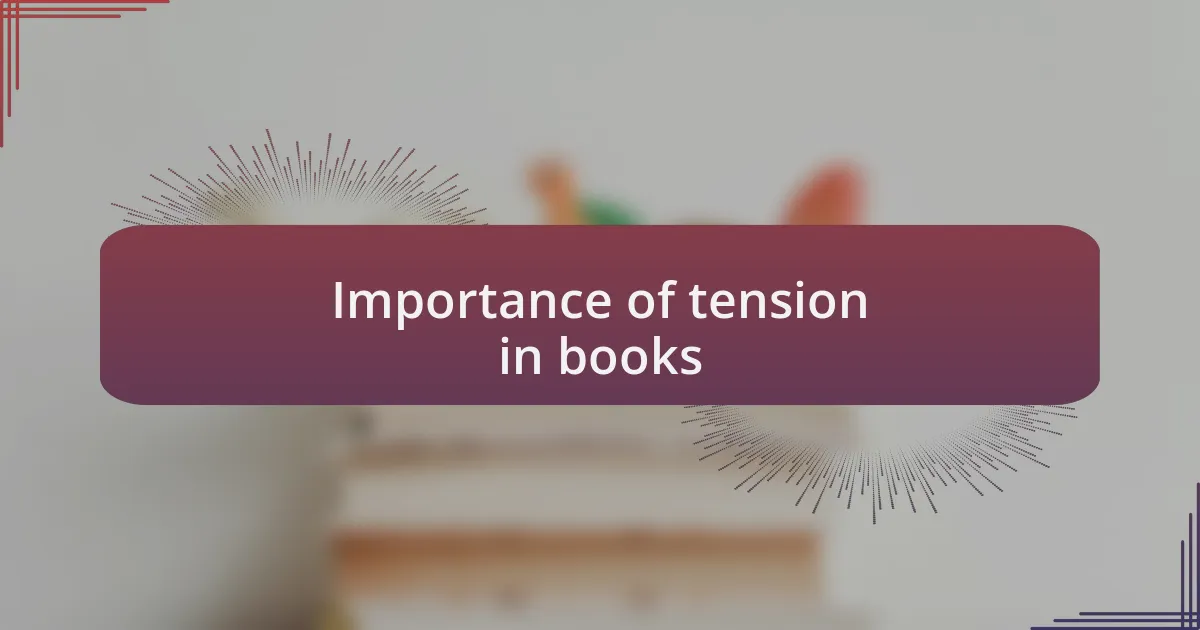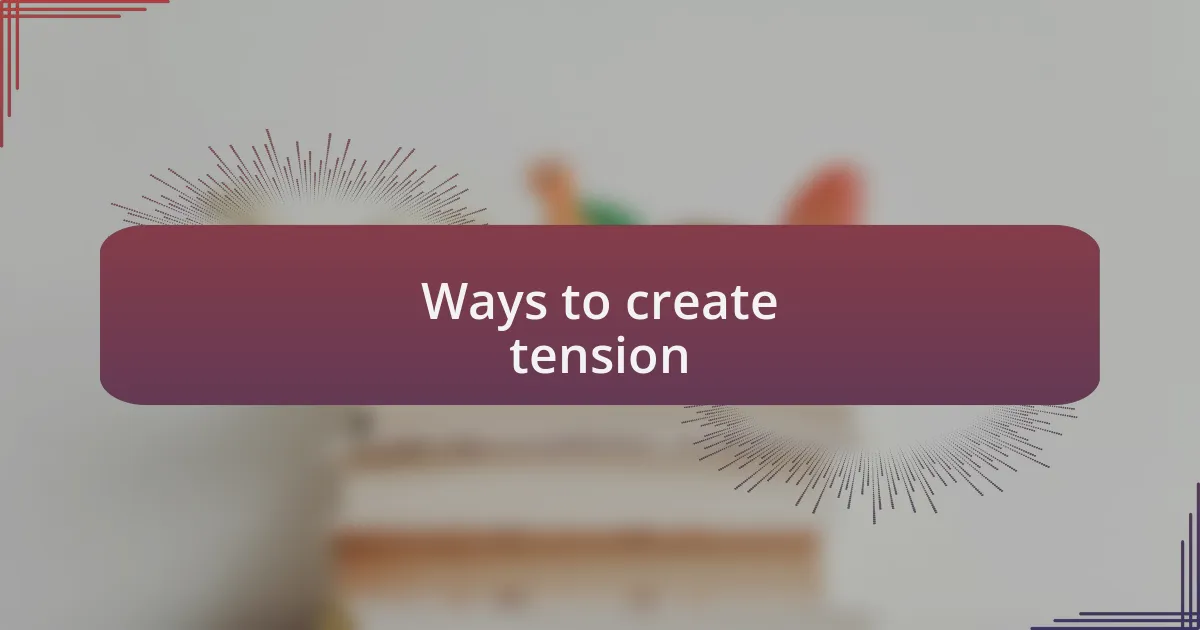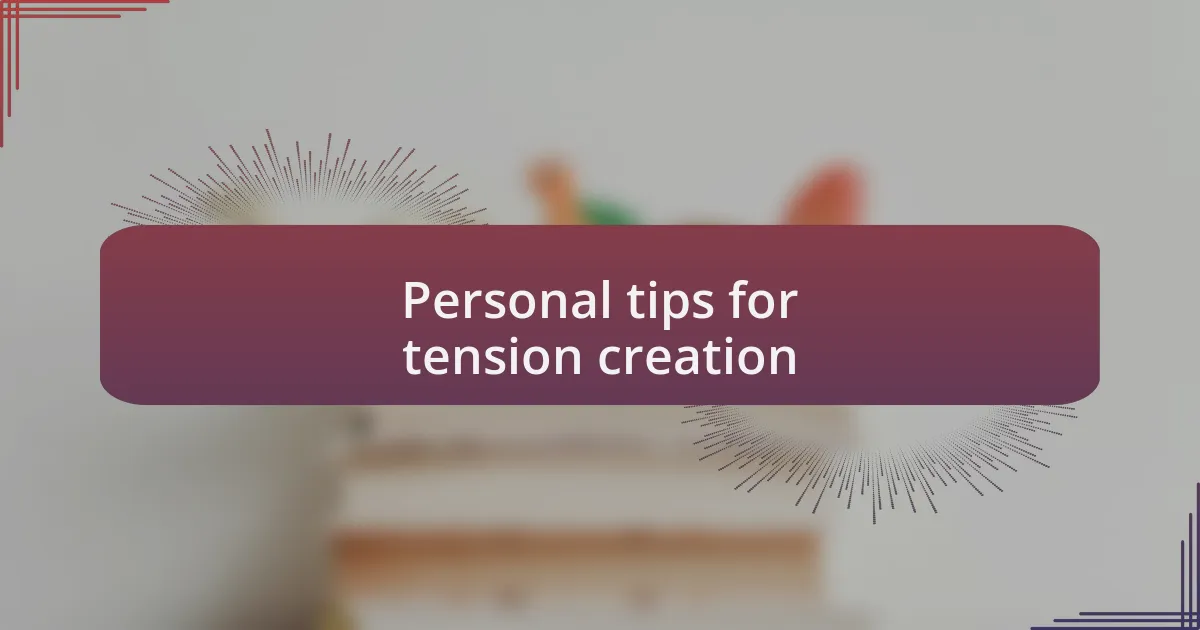Key takeaways:
- Tension is essential in storytelling, driving emotional investment and narrative momentum through conflict and resolution.
- Effective tension can be created by raising stakes, introducing uncertainty, and incorporating unexpected twists.
- Techniques like pacing, foreshadowing, and crafting an atmospheric setting enhance suspense and reader engagement.
- Character complexity and dynamics significantly amplify tension, making interactions feel charged and engaging.

Understanding tension in storytelling
Tension in storytelling is the heartbeat of any narrative, driving the reader’s emotional investment. I remember reading a thriller where every chapter ended with a cliffhanger—my heart raced as I felt a compelling need to uncover what happened next. Isn’t it fascinating how a single twist can keep us glued to the pages?
Creating tension involves a delicate balance of conflict and resolution. I often find myself reflecting on stories where the stakes are high; the characters face seemingly insurmountable odds, and yet their journeys resonate with us. How do authors master the art of building anticipation? It’s often through well-timed revelations and unexpected obstacles that heighten our curiosity.
At times, the emotional complexity of characters amplifies tension, making their struggles feel profoundly relatable. I recall a novel where the protagonist grappled with guilt and desire, which crafted a rich tapestry of conflict. In those moments, don’t you find yourself torn between empathy for the character and the suspense of wondering how they will resolve their dilemmas? This interplay creates a dynamic experience that captivates readers, pulling them into the story with palpable intensity.

Importance of tension in books
Tension is crucial because it propels the narrative forward and keeps readers on the edge of their seats. I recall picking up a fantasy novel where every battle scene felt impossibly tense. The way the author described the stakes not only made me root for the heroes but also immersed me deeply in the story, creating a connection that made the outcome feel personal. Have you ever felt so involved in a story that you couldn’t help but hold your breath during a crucial moment?
Moreover, tension serves to deepen the reader’s emotional engagement with the characters. I remember a romance novel where the couple faced numerous obstacles in their relationship. Each conflict they navigated had me on high alert, and I found myself emotionally investing in their happiness. Isn’t it incredible how a well-crafted tension can turn a simple storyline into a rollercoaster of emotions that lingers with you long after you’ve closed the book?
Finally, the interplay of tension and resolution offers a satisfying payoff that keeps readers coming back for more. I’ve noticed that the thrill of resolution, whether it’s victory, loss, or transformation, resonates deeply after a tense build-up. Doesn’t that moment of relief feel all the more rewarding when it follows a period of uncertainty? In this way, tension doesn’t just serve the story; it enhances our reading experience, leaving an indelible mark on our hearts and minds.

Ways to create tension
To create tension effectively, I believe that raising the stakes for characters is essential. Think of a time when a character faced a ticking clock, racing against time to achieve their goal. I was completely absorbed in a thriller where every second counted, adding layers of urgency that made each moment pulse with anxiety. Don’t you find yourself gripping the book tighter when you know the characters are on borrowed time?
Another powerful method is to introduce uncertainty. I remember reading a mystery where key pieces of information were deliberately withheld. This choice left me questioning everything and everyone—was the hero truly innocent? The thrill of doubt can transform the reading experience, engaging readers in a quest for truth alongside the characters. Isn’t it unforgettable when you’re in the dark, piecing together clues just like the protagonist?
Lastly, incorporating unexpected twists can elevate tension to new heights. I vividly recall one story where a trusted ally turned out to be the antagonist. The shock didn’t just give me whiplash; it made me rethink everything I had read up to that point. How exhilarating is it to be caught off guard, with your emotions flipping dramatically as you try to grapple with the new reality? These moments of surprise can turn a steady narrative into an unforgettable ride.

Techniques for building suspense
One technique that stands out to me is pacing. Slowing down the narrative during critical moments can amplify the tension I feel as a reader. I recall a scene in a psychological thriller where the author took several pages just to describe a character’s mounting dread. The deliberate pace had me on edge, waiting for the inevitable explosion of action. Doesn’t it feel like time stands still in these moments, intensifying every heartbeat?
Another effective method is the use of foreshadowing. I often find myself torn between excitement and anticipation when subtle hints are dropped throughout the story. In one book, an innocuous detail about a seemingly random object became significant later on, changing how I perceived the storyline. It’s like a puzzle slowly revealing itself, and I can’t help but feel a thrill when I connect the dots. Have you ever noticed how those earlier clues stir a sense of satisfaction when they finally click into place?
Atmosphere plays a pivotal role in tension-building as well. I vividly remember a novel set in a stormy coastal town, where the weather mirrored the characters’ turmoil. The dark clouds outside reflected their inner struggles, making every moment feel foreboding. I find that a well-crafted atmosphere can wrap around me like a heavy blanket, amplifying the unease. Doesn’t the environment in a story sometimes feel as if it has a heartbeat of its own, driving the suspense further?

Using characters to enhance tension
Characters are the heartbeat of a story, and I’ve found that their complexities can drastically heighten the tension. Take, for instance, a protagonist haunted by their past; every interaction becomes charged with unspoken fears and unresolved conflicts. I remember reading about a character whose secrets unraveled slowly, making me question their every move. It’s fascinating how their emotional layers can keep me on edge, isn’t it?
In my experience, the dynamics between conflicted characters create palpable tension that pulls me into the narrative. Imagine two characters with opposing goals facing off against each other, each with their motives shrouded in mystery. I find myself leaning closer to the page, eager to see how their clash might unfold. The push and pull of their desires can build an electric atmosphere, where uncertainty reigns. Who doesn’t savor that feeling of being caught in the middle of a high-stakes standoff?
On the flip side, side characters also play a crucial role. A seemingly minor character who knows more than they let on can inject unexpected tension into the plot. I recall a novel where a neighbor’s vague warnings delayed a crucial moment, making the protagonist’s choices feel more urgent. It’s intriguing how even the smallest detail can contribute to an overarching sense of dread. Have you ever felt that thrill when a side character subtly shifts the balance, leaving you wondering about their true intentions?

Personal tips for tension creation
When it comes to creating tension, pacing is a crucial factor I’ve come to appreciate. For instance, I remember reading a thriller that alternated between fast-paced action scenes and slow, introspective moments. This ebb and flow not only kept me engaged but also made me anxious for what was to come. Have you ever noticed how a sudden shift in speed can grip your emotions, leaving you breathless in anticipation?
Another tip I’ve found effective is to embed cliffhangers within chapters. I still recall a novel that ended each chapter with an intriguing question or a shocking revelation, compelling me to keep turning the pages late into the night. The suspense built from these teasing moments creates a sort of addiction, doesn’t it? It’s that pull to want to know what happens next that I find so exhilarating.
Lastly, using foreshadowing can be an excellent way to build tension without the reader even realizing it at first. I often enjoy stories that drop subtle hints—like a shadowy figure in the background or a minor detail that later becomes crucial. When I finally connect those dots, it feels incredibly satisfying and heightens the tension as I revisit earlier moments in the storyline. Have you experienced that thrill of revelation when everything clicks into place?